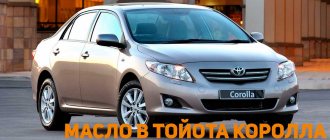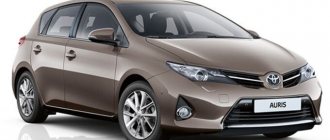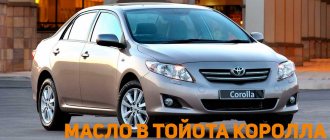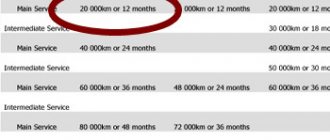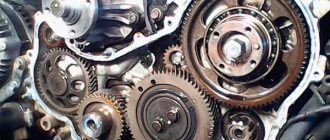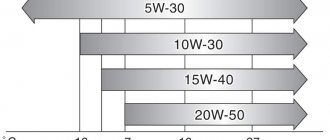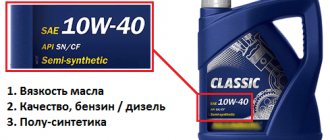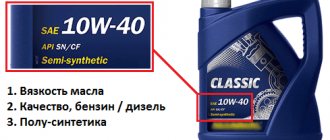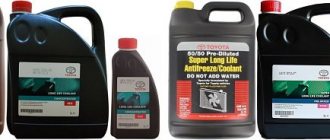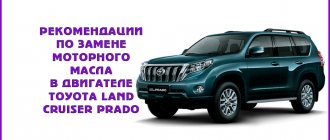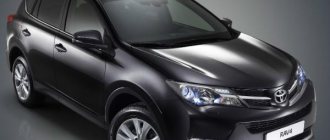All Toyota car owners sooner or later face the issue of choosing a coolant. The modern market offers many effective and high-quality solutions to these problems, but not every driver can make the right choice.
The best option in such cases is Toyota antifreeze, because the automaker knows exactly what its brainchild needs and offers only the best.
Description of Toyota antifreeze
The original antifreeze for Toyota is made on the basis of environmentally friendly and safe polypropylene glycol and effective, carefully balanced additive packages. When creating these coolants, manufacturers paid special attention to protection against corrosion - powerful inhibitors were used in the composition.
On the modern European market you can find two types of branded coolants: Toyota Long Life Coolant and Toyota Super Long Life Coolant.
Currently, most of the automaker's models use the latter brand of antifreeze.
Both antifreezes are supplied ready for use (in a 50/50 ratio with water), and in the form of concentrates, which must be diluted with water before use. For normal operating conditions at temperatures down to -40 °C, water is added at a ratio of one to one.
Depending on the minimum temperature at which the vehicle will be operated, the proportions of concentrate in water can vary from 33 to 70%.
When diluting the concentrate with water, you can use distilled, or even better, deionized water. In extreme cases, you can use tap water. It is strictly not recommended to take water from open reservoirs or wells for cooking.
Tests and tests have shown that both Toyota coolants meet the requirements of not only Japanese, but also leading European, Asian and American manufacturers. Reviews received from car owners and drivers confirm this.
Toyota Long Life Coolant
Toyota Long Life Coolant (LLC) is a red composition based on propylene glycol, functional additives and a corrosion inhibitor. It is designed for engines of both cars and trucks.
This antifreeze was recommended for use in Toyota cars until 2002, however, it remains in demand and popular today.
Antifreeze of this brand is characterized by high heat dissipation properties, perfectly lubricates and protects the engine cooling system from wear and corrosion.
Toyota Long Life Coolant antifreeze is supplied to Russia in the following packaging:
- 1 l – article 08889-80015
- 4 l – article number 08889-80032
- 5 l – article number 08889-80014
- 60 l – article number 08889-80017
Toyota Super Long Life Coolant
Toyota Super Long Life Coolant (SLLC) is used for filling on the conveyor. It is also used for further replacement. Suitable for all modern engines of passenger cars and trucks.
In the production of this pink antifreeze, carboxylate technology (additives based on organic acids) is used. Polypropylene glycol is used as a cooling base. The antifreeze does not contain nitrates, silicates and other components that form deposits in the system, thereby reducing the efficiency of heat transfer.
This liquid not only helps maintain normal thermal operating conditions of the engine, but also perfectly prevents cavitation and foam formation.
Toyota antifreeze (SLLC) is available in the following packaging
X:
- 2 l – article 08889-80070
- 4 l – article number 08889-80071
- 5 l – article number 08889-80072
Longlife antifreeze Peugeot and Citroen and its analogues
Disclaimer: all information contained on these pages above and below is not advertising, all illustrations, brands and names of liquids are fictitious, the matches are random, and the coolants are listed below in a chaotic order.
First we list the original coolants from the PSA Group catalog. You can buy them at Peugeot or Citroen service centers. The high quality of these liquids is undoubtedly. They are produced by Arteco, which is part of the TOTAL Group.
- 9735.K4 – concentrate, and 9735.K5 – ready-made solution, 1 l canister
- 9735.K1 - ready-made solution, -35°C, 2 l canister
- 9735.K0 - ready-made solution, -35°C, 5 l canister
Ready-made solutions 9735.J9 in a 20-liter canister and 9735.J8 in a 210-liter barrel can be purchased upon pre-order.
9735.K4
9735.K1
9735.K0
9979.A5
9979.A6
9979.A6
9735.Y5
9735.Y6
9735.Y6
Partner DSR is produced in Russia, has a PSA B71 5110 approval and is supplied to the conveyor of the PCMA plant in Kaluga. Despite all the strict control over high quality on the part of Total and PSA Peugeot Citroen, this coolant is often blamed for premature loss of properties and the need for immediate premature replacement.
Partner DSR
Areca Technigel G33 , a French product, has direct approval from PSA B71 5110. It contains components from one of their general manufacturers - Glysantin. In fact, this is a liquid completely identical to the original one.
Areca Technigel G33
- Valvoline Multi-Vehicle Coolant RTU and Multi-Vehicle Coolant Concentrate are ready-made coolant and concentrate, all PSA approved.
Valvoline Multi-Vehicle Coolant Concentrate
- Gulf Antifreeze XLL is an antifreeze with specification B71 5110 from the famous brand.
Gulf Antifreeze XLL
- Fuchs Maintain Fricofin LL - “Made in Germany”, in compliance with specification B71 5110. When purchasing it, pay attention to the mandatory presence of the letters “LL” in the name.
Fuchs Maintain Fricofin LL
- Q8 Long-Life Antifreeze Premixed or Concentrate - already diluted or concentrate. The Q8 brand (pronounced "Queight" or "Kuwait") produces antifreeze that meets the B71 5110 specification.
Q8 Long-Life Antifreeze Premixed
Q8 Long-Life Antifreeze Concentrate
- MPM Antifreeze Premium Longlife G12+. The MPM brand is trusted by fans of drifting and drag racing. However, it also produces high-quality antifreeze with the specification we need.
MPM Antifreeze Premium Longlife G12+
- Kroon Oil Coolant SP14 has direct approval from PSA.
Kroon Oil Coolant SP14
- Wolf Coolant-36°C Longlife G12+ complies with specification B71 5110, but don’t be confused by the fact that there is no mention of this on the label - everything is on the website.
Wolf Coolant-36°C Longlife G12+
- Champion Longlife G12+ -36C - exactly the same as the previous one, produced in the same place, with the same high quality and compliance with the tolerance.
Champion Longlife G12+ -36C
- Rowe Antifreeze AN-SF 12+ - can be used with confidence.
Rowe Hightech Antifreeze AN-SF 12+
- Liqui Moly Kühlerfrostschutz Konzentrat KFS 33 - in addition to “Made in Germany” and approval from PSA, it also has approval from Toyota.
Liqui Moly Kühlerfrostschutz Konzentrat KFS 33
- G-Energy Antifreeze SNF from Gazprom is very common and complies with specification B71 5110. This is only indicated in the illustration. There is no information on the label or website.
G-Energy Antifreeze SNF
- On the website and on the label, Felix EVO demonstrates compliance with B71 5110 twice - from Citroen and from Peugeot, so we recommend it. But on the Felix Type D they write in large numbers that they say - for Nissan, and for Renault, and for Peugeot and Citroen. But there is no mention of approval ANYWHERE - neither on the website nor on the label! As they say in Odessa: “something is not kosher here.”
Felix EVO
Felix Type D
- Patron G12+ Yellow is another domestic product with the PSA B71 5110 specification, which is indicated on the label. But! It is a clear proof of the uselessness of the “G...” designations - the same antifreeze, but G12+ Red does not have approval from PSA, although in theory it should be exactly the same.
Patron G12+ Yellow
- Samson EU-Standart G12+ is a product from Belarus that meets specification B71 5110.
Samson EU-Standard G12+
- MaxLane G12-40 is also from Belarus, and is produced under a BASF license, meeting PSA approval.
MaxLane G12-40
How often should Toyota antifreeze be replaced?
It is recommended to replace Toyota Long Life Coolant antifreeze every 40,000 km or according to service life - after the factory one after three years, then every 2 years.
The manufacturer recommends the first replacement of Toyota Super Long Life Coolant antifreeze after 160,000 km, and then every 80,000 km. If we focus on service life, the manufacturer states that this fluid must be replaced every 5 years.
However, these recommendations are too approximate and indicate the maximum limits, upon reaching which the antifreeze must be replaced.
During the operation of Toyota vehicles, various situations may arise when the coolant must be changed earlier than specified.
For example, if you bought a used car and do not know what kind of antifreeze is poured into the cooling system, then when its level in the expansion tank decreases, you should not add liquid of the same color. It is better to make a complete replacement, regardless of mileage or service life. This will save you from many problems - antifreezes of different chemical compositions, when mixed, can cause sedimentation, lose or reduce cooling, protective and lubricating properties.
How to determine when it's time to replace?
In order to promptly replace antifreeze in Toyota cars, you must adhere to several rules, which, however, are valid for vehicles of any manufacturer and any brand.
- First, you should follow the replacement interval recommendations from the vehicle manufacturer and coolant manufacturer.
- Secondly, it is advisable to completely update the antifreeze when buying a used car, if you don’t know exactly what kind of liquid is in it.
- Thirdly, it is necessary to periodically monitor the liquid level in the expansion tank. When adding any liquid of different composition to it, at the first opportunity it is necessary to flush and completely replace the antifreeze.
- Fourthly, the appearance of the liquid poured into the system should be monitored. Its contamination, loss of transparency or discoloration indicate a decrease or complete loss of working properties. In this case, it is also necessary to replace the antifreeze.
Is it possible to mix different antifreezes?
Is it possible to mix antifreeze of different brands and colors?
Is it possible to dilute one antifreeze with a liquid of another brand from the same manufacturer? Will a mixture of different antifreezes of the same color damage the engine? These questions concern almost every car owner and driver.
The answer to these questions is simple - without any harm to the car, you can only mix antifreezes of the same chemical composition.
If both fluids are made from polypropylene glycol using the same additive packages, then they can be mixed regardless of what color dye is added to them.
Most often, we don’t know the exact composition, so it’s better not to take risks. Additives that differ in their chemical composition can react with each other, causing deposits in the system, reducing certain performance properties that are required from antifreeze specifically for your car model.
As for Toyota antifreezes, the manufacturer categorically does not recommend mixing Toyota Super Long Life Coolant and Toyota Long Life Coolant liquids with each other, because they use additives of different compositions.
How to spot a fake
Original antifreezes suitable for a specific car brand are not counterfeited as often as universal ones, but the possibility of counterfeiting cannot be completely ruled out. Which Toyota antifreeze is original and which is not? Counterfeit is determined by the following criteria:
- defects in the seam area of the canister;
- a cover that does not fit tightly to the ring, the presence of chips, scratches and other signs of tampering along its edges;
- unevenly glued labels, the presence of traces of glue, folds and bubbles on them;
- the information on the packaging is false or contains errors;
- the text is blurry, there are uneven lines;
- The release and bottling date is difficult to read.
If the appearance of the canister is in doubt, then it is better to refuse to purchase antifreeze and its subsequent use.
